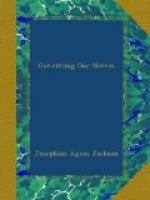=Construction.= There is an innate satisfaction in making something,—from a doll-dress to a poem,—and this satisfaction rests on the impulse to construct, to fashion something with our own hands or our own brain. The emotion accompanying this instinct is too indefinite to have a name but it is nevertheless a real one and plays a large part in the sense of power which results from the satisfaction of good work well done. Later it will be seen how closely related is this impulse to the creative instinct of reproduction and how useful it can be in drawing off the surplus energy of that much denied instinct.
=Pugnacity and Anger.= What is it that makes us angry? A little thought will convince us that the thing which arouses our fury is not the sight of any special object, but the blocking of any one of the other instincts. Watch any animal at bay when its chance for flight has gone. The timidest one will turn and fight with every sign of fury. Watch a mother when her young are threatened,—bear, or cat or lion or human. Fear has no place then. It is entirely displaced by anger over the balking of the maternal instinct of protection. Strictly speaking, pugnacity belongs among the instincts neither of self-preservation nor of race-preservation, but is a special device for reinforcing both groups.
As fear supplies the energy for running, so anger fits us for fight,—and for nothing but fight. The mechanism is almost identical with that of fear. Brain and liver, adrenals and thyroid are the means, but the emotion presses the button and releases the energy, stopping all digestion and energizing all combat-muscles. The blood is flooded with fuel and with substances which, if not used, are harmful to the body. We were never meant to be angry without fighting. The habit of self-control has its distinct advantages, but it is hard on the body, which was patterned before self-control came into fashion. The wise man, once he is aroused, lets off steam at the woodpile or on a long, vigorous walk. He probably does not say to himself that he is a motor animal integrated for fight and that he must get rid of glycogen and adrenalin and thyroid secretion. He only knows that he feels better “on the move.”
The wiser man does not let himself get angry in the first place unless the situation calls for fight. However, the fight need not be a hand-to-hand combat with one’s fellow man. William James has pointed out that there is a “moral equivalent for war,” and that the energy of this instinct may be used to reinforce other impulses and help overcome obstacles of all sorts. A good deal of the business man’s zest, the engineer’s determination, and the reformer’s zeal spring from the fight-instinct used in the right way. As James, Cannon, and others have pointed out, the way to end war may be to employ man’s instinct of pugnacity in fighting the universal enemies of the race—fire, flood, famine, disease, and the various social evils—rather than let it spend its force in war between nations. Even our sports may be offshoots of the fight-instinct, for McDougall holds that the play-tendency has its root in the instinct of rivalry, a modified form of pugnacity. Evidently fighting-blood is a useful inheritance, even to-day, and rightly directed is a necessary part of a complete and forceful personality.




